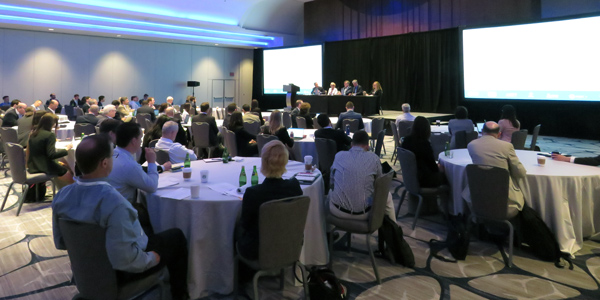WASHINGTON — Former FERC Chairman Pat Wood III used his keynote speech at last week’s Future Power Markets Summit to “re-serve the Kool-Aid” on the value of competitive markets threatened by state subsidies and the Trump administration’s push for price supports for coal and nuclear generation.
He referred to the “economic carnage” caused by the over-budget Vogtle and Summer nuclear plants in Georgia and South Carolina and the Kemper “clean coal” project in Mississippi, citing estimates that they will saddle ratepayers in the cost-of-service Southeastern states with $123 billion in excess costs over 40 years.
“That’s a lot. That’s not a rounding error, folks,” he said. “This is what happens when you do not have the discipline of markets,” he said.
Wood contrasted that with the savings seen in ERCOT’s competitive energy-only market, where retail power prices have declined to about 8 cents/kWh, down from 10.5 cents before competition. Wood credited the savings to cheap wind and natural gas generation, dozens of competitive retail suppliers and lower profit margins.
“When I was a regulator, we would give a utility a 16% pretax rate of return on equity. … When I was [chairman] at Dynegy, we were happy to get 3[%].”
The conference was sponsored by the American Wind Energy Association, American Council on Renewable Energy, Solar Energy Industries Association, American Public Power Association, National Rural Electric Cooperative Association, Large Public Power Council and Energy Systems Integration Group (ESIG), a nonprofit educational association for engineers, researchers, technologists and policymakers. (See related story, ‘Almost Nobody is Happy’ with Capacity Markets at Conference.)
Wood told the 80 attendees he feared grid modernization could lead to a “gold plating” of the distribution and transmission systems that erodes the savings from cheap natural gas and renewable generation. “I don’t want to see all the savings I get from crunching down on the [generation] be offset by adding a lot to” transmission.
Beth Garza, director of ERCOT’s Independent Market Monitor, expressed a related concern. “We can spend dimes on transmission to save dollars in generation costs, and we’ve done that,” she said, referring to the competitive renewable energy zone (CREZ) transmission built to deliver West Texas wind. “I think, though, that over the years … we’ve reached a point now where we’re starting to spend quarters on transmission to potentially [save] quarters on the energy side. I’m not sure there’s the appropriate discipline and review on the regulatory side to bring those two in balance.”
Garza also questioned the distinction between “the big poles and wires [transmission] and small poles and wires [distribution].”
“Distribution utilities have a fixed investment in the small poles and wires and transformers and that is recovered through a variable rate, and so of course they don’t want people with PVs on their roof diminishing their consumption and diminishing their payment,” she said. She suggested the variable rates on distribution be replaced with fixed rates to acknowledge that both transmission and distribution enable the connection between customers and resources.
Jeff Bladen, MISO’s executive director for market design, discussed three “mega trends” that he said must be addressed by RTO markets: digitalization, including the Internet of Things; decentralization of generation; and “demarginalization” resulting from the rise of low- and no-marginal-cost resources.
“Our markets are moving away from the marginal cost of energy being the primary means for signaling the operational needs of the grid,” he said. “As we move forward, our history of everyday scheduling our generation and forecasting our load is beginning to switch. We’re going to look at a future where much more of our supply is a forecast and much more of our demand is something we try to schedule — digital devices and the like.”
Robin Hytowitz, an electrical engineer for the Electric Power Research Institute, noted that FERC-jurisdictional RTOs and ISOs “have started to integrate fixed operating costs from fast-start resources into prices.”
But she lamented that “demand-side bidding versus retail choice isn’t very active in most markets.”
“I think that actually having a demand curve for these markets would help advance some of the price formation efforts. So, we could get the demand side in addition to the supply-side curve.”
Mark Ahlstrom, board president of ESIG, argued for maximizing the granularity and flexibility of resources that provide ancillary services.
“Suppose I need 100 MW on reserve and in order to qualify to even offer it into the market, I have to be able to provide a four-hour sustained duration. Do I really want to have one product — 100 MW for four hours of sustained duration? Or would I rather have four 100-MW units that can each sustain duration for only one hour? I would argue that — without question — you want the latter, because … I can also use those building blocks in other ways.”
Ahlstrom said although more granular resources should be cheaper, pricing them is a challenge.
“Any time we block those capabilities into hourly type products or anything like that in order to price them … we are leaving a lot of the capability and flexibility on the cutting room floor. An engineer in the control room would like to have continuous control over everything if we can figure out how to run markets that way.”
Ahlstrom said he previously thought it unwise to combine storage with a renewable resource because it increases the cost of energy. “The market should be the cheapest source of flexibility if it’s working right,” he said.
“I’ve had to eat my words on that because we’re seeing huge demand; we’re going to see a ton of these hybrid projects,” he continued. “And why is that? It’s because in the markets as they’re operating today, it’s way too tough to get through the interconnection process and connect new resources separately. … A lot of this is a reflection that we can’t just have a frictionless way of adding resources to the markets.”
— Rich Heidorn Jr.










